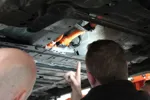Review
Working out whether diesel is cost-effective has become quite a conundrum for consumers.
A price differential of 11 or 12p per litre, combined with the premium paid for diesel models over petrol makes, has pushed the breakeven point of diesel thousands of miles further along the road.
This factor isn’t fully understood by many car buyers, who assume that choosing diesel will automatically save them money.
The cost of choosing a large car with a diesel engine is more expensive than it was five to 10 years ago.
This is partly a response to the increased demand for diesel, but another element is the fitment of expensive particulate filters to ensure cars comply with emissions regulations.
And of course, most diesel engines have a turbo bolted on which is less common on their petrol equivalents.
Take, for example, the Honda Civic.
New prices show a £1,300 premium for the 2.2-litre diesel over the 1.8-litre petrol.
Taking £1.10 as the price of unleaded and £1.22 as the price of diesel, the distance needed to travel to break even on diesel is enormous.
With so many diesels on the used market, the gap in values between petrol and diesel models has shrunk, so someone trading in a diesel Civic after three years can only expect to be offered perhaps £400 more than for a similar petrol version.
In this scenario, taking into account the average fuel consumption of both models, the premium for the diesel when new, and the expected higher return on the diesel when trading in, the numbers still favour the petrol model, even after 60,000 miles.
This isn’t just peculiar to the Civic – there are dozens of cars where the numbers are comparable.
On the other hand, buying a medium-sized diesel car at three years old, the premium over petrol models is far easier for buyers to recoup.
Factsheet
No information available.













